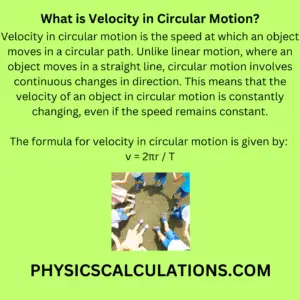What is Velocity in Circular Motion?
Velocity in circular motion is the speed at which an object moves in a circular path. Unlike linear motion, where an object moves in a straight line, circular motion involves continuous changes in direction. This means that the velocity of an object in circular motion is constantly changing, even if the speed remains constant.

Do you ever wonder how objects move in a circle without falling off? It’s all thanks to the concept of velocity in a circular motion. In this article, we will delve deeper into the science behind this concept. We will also explore its various applications in our daily lives
Formula
The formula for velocity in circular motion is given by: v = 2πr / T
Where: v = velocity π = the mathematical constant pi (approximately equal to 3.14159) r = the radius of the circular path T = the time taken for one complete revolution
This formula tells us that the velocity of an object in circular motion depends on the radius of the circle and the time taken for one complete revolution. As the radius of the circle increases, the velocity of the object also increases. Similarly, as the time taken for one complete revolution decreases, the velocity of the object increases.
Understanding Centripetal Force
Velocity in circular motion is closely related to the concept of centripetal force. Centripetal force is the force that keeps an object moving in a circular path. It is directed towards the centre of the circle. Additionally, it is proportional to the mass of the object and the square of its velocity.
The formula for centripetal force is given by:
F = mv2 / r
where: F = centripetal force m = mass of the object v = velocity of the object r = radius of the circular path
This formula tells us that the centripetal force required to keep an object moving in a circular path increases with the mass of the object and the square of its velocity. This means that the faster an object moves in a circular path, the greater the centripetal force required to keep it moving.
Applications
Velocity in circular motion has many applications in our daily lives. Here are a few examples:
Amusement Park Rides
Amusement park rides such as roller coasters and Ferris wheels rely on this concept to provide a thrilling experience for riders. The circular motion of the ride generates centrifugal force, which pulls riders towards the outside of the circle. This creates a feeling of weightlessness and adds to the excitement of the ride.
Sports
Many sports involve circular motion, such as figure skating, ice hockey, and gymnastics. In figure skating and ice hockey, athletes use a circular motion to move around the rink and perform spins and turns. In gymnastics, athletes use a circular motion to perform flips and twists on the uneven bars and the balance beam.
Astronomy
The planets in our solar system move in circular orbits around the sun, and the moons of these planets move in circular orbits around their respective planets. The velocity of these objects in circular motion is determined by their distance from the centre of the orbit and the time taken for one complete revolution.
Frequently Asked Questions
- What is the difference between linear and circular motion? Linear motion involves an object moving in a straight line, while circular motion involves an object moving in a circular path.
- Can an object move in a circular motion without a centripetal force? No, an object cannot move in circular motion without a centripetal force. The centripetal force is necessary to keep the object moving in a circular path.
- What happens to the velocity of an object in a circular motion if the radius of the circle increases? It increases as the radius of the circle increases.
- How does velocity in circular motion affect centripetal force? Velocity in circular motion is directly proportional to the centripetal force required to keep the object moving in a circular path.
- What are some examples of circular motion in everyday life? Examples of circular motion in everyday life include the motion of a ceiling fan, the motion of a car around a round
You may also like to read: